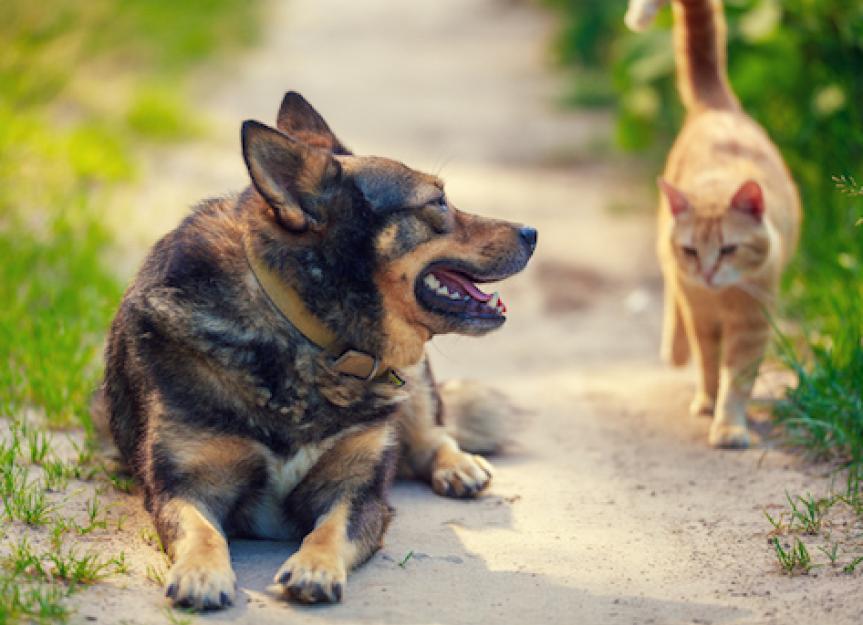4 Heat-Related Risks in Pets You Should Watch Out For
By Hanie Elfenbein, DVM
Dogs and cats are sensitive to heat and can get very sick, very quickly, if their temperature rises too high. A normal body temperature for dogs and cats is higher than in humans, ranging from 100 to 103 degrees Fahrenheit. As air temperature rises above your pet’s body temperature, it becomes more difficult for them to expel excess heat and heat sickness becomes more likely. When their internal temperature rises above 103 degrees, it can cause signs of illness. Anything above 106 degrees can be fatal and requires immediate medical attention.
Here’s a look at some heat-related risks in pets you should watch out for, and advice on how to treat and prevent them.
Skin Fold Pyoderma
Dogs and cats don’t sweat the way humans do. They sweat through their paw pads and expel excess heat by panting. They don’t have sweat glands where they have fur. This means that they don’t get heat rash the way humans do.
Heat rash in humans is caused by clogged sweat glands and irritation, often from tight or non-breathable clothing in hot or humid environments. The rubbing of skin that causes heat rash in humans does have an analogy in dogs with skin folds due to breed type or being overweight. These dogs are at risk for developing a rash and an infection in those skin folds, called skin fold pyoderma, that can be very itchy and uncomfortable.
最好的方法来治疗皮肤褶皱pyoderma is with medicated shampoo to get rid of the excess yeast or bacteria. You should also see your veterinarian to determine whether an antibiotic is needed. Your veterinarian will likely recommend wiping the folds with medicated wipes and keeping them dry.
Paw Pad Burns
Walking on hot ground (especially pavement, concrete, or asphalt) can cause severedamage to a dog’s paw pads. If you can’t keep your hand on the surface for at least five seconds without it feeling uncomfortable, it is too hot for your dog to walk on. Choose a path where your dog can walk on the grass or in dirt. Or, purchase protective booties for your dog (they can also be helpful in the cold and snow). If your dog’s paw pads do get burned or become raw, it takes a long time for them to heal. They will likely require frequent bandage changes, which can be time consuming and expensive for you and uncomfortable for your dog.
Dehydration
Playing outside without access to water can cause dogs to become dehydrated. Dehydrated dogs don’t feel well and are at risk for more serious illness. Since we can’t tell our dogs to pre-hydrate, always carry water for your dog and offer it periodically. Freeze a large bottle of water before going out with your dog on a hike or a picnic. As the water melts, you have cold water to offer your dog (and as a bonus, it will keep your lunch cold).
Heat Exhaustion
Panting when playing outside is normal. Difficulty breathing is not. Signs of heat exhaustion include:
- Excessive panting
- Drooling
- Reddened gums
- Vomiting
- Diarrhea
- Mental dullness
- Uncoordinated movement
- Collapse
If you notice any of these signs, start treatment immediately. Wet down your dog with cool water. If you are using a hose, make sure to let any hot water out first before hosing down the dog. Let your dog drink as much as he or she wants to without force. Call your veterinarian or the nearest emergency clinic and let them know you are on your way. They will tell you what to do next based on your dog’s symptoms and how far away you are from the clinic.
Risk Factors for Heat-Related Sickness
Dogs are at higher risk from heat exposure because we take them with us on summer adventures. Remember to go at your dog’s pace on a walk or hike, take plenty of water breaks, and encourage rest.
Cats who stay inside can lay in a sunny spot on the floor while being cooled by the air conditioner or a fan. Cats who spend time outside will usually find cool places to rest during the heat of the day. The cats at highest risk from heat are those who don’t have access to clean, fresh water or those who accidentally get locked outside.
Some dog breeds are more at risk for heat-related sickness. This includes short-nosed breeds such as Bulldogs, Boxers, and Pugs. Other risk factors include old or young age, obesity, or thick coats best adapted to cold climates.
Dogs who are not used to being outside in the heat or humidity are more likely to show signs of heat sickness. Adapt your dog with short playtimes outside in the morning and evening, slowly adding on more time and at hotter parts of the day. Always ensure that your dog has access to shade and drinking water.
Help us make PetMD better
Was this article helpful?
